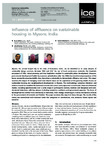Influence of affluence on sustainable housing in Mysore, India
| dc.contributor.author | Satish, BK | en |
| dc.contributor.author | Brennan, J | en |
| dc.contributor.author | Pedreschi, R | en |
| dc.date.accessioned | 2016-09-29T09:53:31Z | |
| dc.date.available | 2016-09-29T09:53:31Z | |
| dc.date.issued | 2011-12-01 | en |
| dc.identifier.issn | 1478-4629 | en |
| dc.identifier.uri | http://hdl.handle.net/10026.1/5499 | |
| dc.description.abstract |
Mysore, the second largest city in the state of Karnataka, India, can be identified as an early adopter of sustainable design practices. Between 1903 and 1947 the use of local construction materials, the Swadeshi movement of 1905, robust planning and clear legislation resulted in sustainable urban development. However, post-colonial development fuelled by economic globalisation after the 1980s has transformed perceptions of the house among the growing middle class, becoming a commodity to demonstrate affluence and status. This paper examines the impact of changing social and cultural values on the aspirations of the growing middle classes on sustainable housing and neighbourhood development in Mysore. The methodology comprises literature and archive research to establish the historical content and review some important recent trends. Extensive fieldwork studies, including questionnaires over a wide range of participants (owners, builders and designers) and semistructured interviews with key players, including academics, architects and government agencies. The focus of development has shifted from community to individual, from energy conserving to a more consumerist attitude in the procurement of materials and finishes. The paper examines the impact of these changes. The results of the survey are summarised and reviewed under the categories of communities, site, entrance, house layout and materials. | en |
| dc.format.extent | 249 - 260 | en |
| dc.language.iso | en | en |
| dc.title | Influence of affluence on sustainable housing in Mysore, India | en |
| dc.type | Journal Article | |
| plymouth.issue | 4 | en |
| plymouth.volume | 164 | en |
| plymouth.publication-status | Published | en |
| plymouth.journal | Proceedings of the Institution of Civil Engineers: Engineering Sustainability | en |
| dc.identifier.doi | 10.1680/ensu.2011.164.4.249 | en |
| plymouth.organisational-group | /Plymouth | |
| plymouth.organisational-group | /Plymouth/Users by role | |
| plymouth.organisational-group | /Plymouth/Users by role/Academics | |
| dc.identifier.eissn | 1751-7680 | en |
| dc.rights.embargoperiod | Not known | en |
| rioxxterms.versionofrecord | 10.1680/ensu.2011.164.4.249 | en |
| rioxxterms.licenseref.uri | http://www.rioxx.net/licenses/all-rights-reserved | en |
| rioxxterms.type | Journal Article/Review | en |


